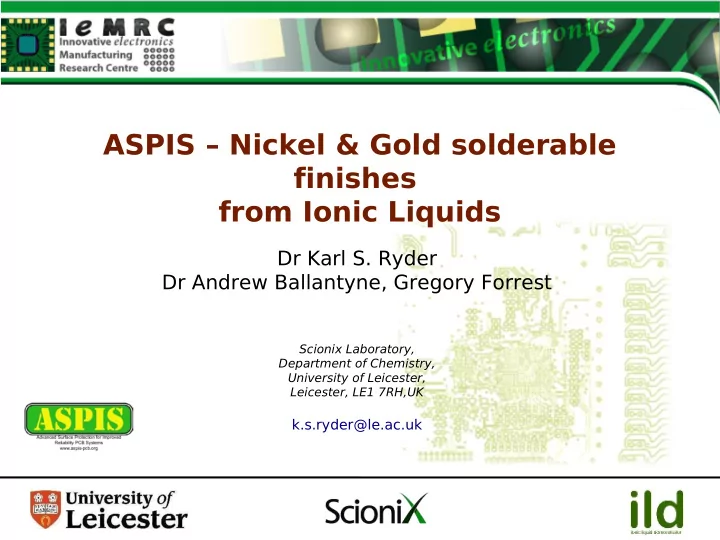

ASPIS – Nickel & Gold solderable finishes from Ionic Liquids Dr Karl S. Ryder Dr Andrew Ballantyne, Gregory Forrest Scionix Laboratory, Department of Chemistry, University of Leicester, Leicester, LE1 7RH,UK k.s.ryder@le.ac.uk
Contents • ENIG and Current Problems • Ionic liquids • Why immersion gold from ionic liquids onto electroless nickel • Standard aqueous sample • Comparison of aqueous and ionic liquid methods • Further work
ENIG and current problems Au Ni • ENIG – Electroless Nickel Immersion Gold • Thick electroless Ni/P deposit (c.a. 6-8 µm Cu thick) Fibre Board • Thin immersion Au coating (>50 nm thick) •Wets solder well, good planarity, long shelf life and high reliability • Problems: Black Pad • Immersion Au inherently a corrosive process • Accelerated corrosion of Ni/P substrate during immersion Au plating • Related to acid medium required for aqueous plating
Ionic Liquids • Organic cations with halide anions and various complexing agents to make an anionic complex • R 1 R 2 R 3 R 4 N + [X - · z Y] • Ionic liquid used here Ethaline 200 • 2:1 molar ratio ethylene glycol complexing and choline chloride agent • Environmentally benign/cheap cation anion materials • Unusual solvation properties of metal salts
Why use ionic liquids? • Problems with ENIG associated with hypercorrosion of nickel substrate during immersion Au • Ionic liquid metal speciation and behaviour at metal surfaces considerably different to molecular solvent i.e. high solubility of metal oxides • Possibility of breakdown of passive Ni layer from neutral ionic liquid media • High quality Au deposits from considerably more benign environment
Standard Aqueous Sample • Developed standard aqueous electroless Ni to study difference in Au plating solutions • Electroless Ni plating solution • 0.1 M NiCl 2 • 0.25 M Na 2 PO 2 H 2 • 0.1 M malonic acid • 0.4 M glycine • pH 4.5 • Plating at 80 ºC for 45 mins • Aqueous immersion Au solution • 5 mM KAu(CN) 2 • 0.1 M citric acid • pH 4.5 • Plating at 80 ºC for 45 mins
Various Au salts in Ethaline 200 • High Cl - content in Ethaline 200 ( c.a. 5 M) gives rise to novel Au salt species • Use of AuCl, AuCN and KAu(CN) 2 • Sequential introduction of CN into Au species in ionic liquid 6 • Electrochemical behaviour of these AuCl 5 AuCN species remarkably varied KAu(CN) 2 4 Current (µA) 3 2 1 0 -1 -1.0 -0.5 0.0 0.5 1.0 1.5 Potential (V)
Plating from Au cyanide salts • IL solutions of AuCl, AuCN or KAu(CN) 2 or standard aqueous sample • 40 mins @ 80 ºC AuCl AuCN KAu(CN) 2
Plating from Au cyanide salts: Plating Rate • in situ measurement of mass deposited by Quartz Crystal Microbalance (QCM) • quartz crystal resonates at specific frequency in response to A.C. current • frequency varies dependent on mass on crystal surface Sauerbrey Equation
Plating from Au cyanide salts: Plating Rate 18 (a) (b) 1.0 16 14 0.8 Mass deposited Aqueous AuCl frequency 12 with time response Admittance (mS) 10 0.6 Mass (µg) 8 AuCl 0.4 6 AuCN 4 0.2 2 KAu(CN)2 0 0.0 -2 8.20 8.22 8.24 8.26 8.28 8.30 8.32 0 200 400 600 800 1000 1200 1400 1600 1800 Frequency (MHz) Time (s) Salt Plating Rate (nm min -1 ) Aq KAu(CN) 2 1.75 AuCl 1.16 AuCN 0.76 KAu(CN) 2 0.37 Na 3 Au(S 2 O 3 ) 2 1.45
Plating from Au cyanide salts: Comparative morphologies Aq AuCl KAuCN AuCN 2
Plating from Au cyanide salts: Comparative morphologies Evidence of hypercorrosion of aqueous immersion Au sample
Plating from Au cyanide salts: Comparative morphologies Aq AuCl AuCN KAu(CN) 2
Plating from Au cyanide salts: Comparative morphologies Aq AuCl AuCN KAu(CN) 2
Plating from Au cyanide salts: Comparative surface roughness Salt % Surface area difference % Surface area difference (%SAD) @ 20 µm (%SAD) @ 2 µm Aq KAu(CN) 2 4.13 9.27 AuCl 12.6 180 AuCN 1.94 4.03 KAu(CN) 2 2.65 3.78
Plating from Au cyanide salts: Stripped Au surface Aqueous AuCl in Eth 200 AuCN in Eth 200 KAu(CN) 2 in Eth 200 Ils show less evidence of “mud cracking” Aqeous shows a number of corrosion features which are not present in the IL samples.
Plating from Au cyanide salts: Plating of standard tokens Immersion Au from AuCN or KAu(CN) 2 in Ethaline 200 onto aqueous electroless Ni/P AuCN gives bright uniform coatings KAu(CN) 2 gives very thin coatings
Solder Wetting Balance Measurements Rate at which solder wets surface and reliability with which it does is a good indicator of standard of ENIG coatings 4 t 1/2 3 3 Force (mN) 2 1 2 0 1 -1 0 2 4 6 8 Time (s) t 1/2 = time for force measurement to reach half of its maximum value
Solder Wetting Balance Measurements 4 3 t 1/2 (s) 2 1 0 Aqueous AuCN KAu(CN)2 Coatings from ILs wet faster and more reliably than the model aqueous process
Comments and Future directions Extensive studies on effect of including cyanide in immersion bath; o Improved coating with increasing cyanide content. o Rate of deposition decreases with increasing cyanide content. o AuCN and KAu(CN) 2 coatings have lower roughness than aqueous. o Good coatings onto standard tokens. o Coatings from AuCN and KAu(CN) 2 in Ethaline 200 wet faster and more reliably on a solder wetting balance. Investigate use of additives on coating quality Ageing studies on solder wetting balance and XPS Metal ion speciation studies by UV and EXAFS (proposal submitted)
Recommend
More recommend